Rebecca Eanes's Blog, page 9
November 10, 2015
8 Actions to Chase Away the Mama Blues
 Photo Credit: Creative Child Magazine
Photo Credit: Creative Child MagazineMotherhood is beautiful and joyful. It’s also exhausting and monotonous. Taking care of the ever-present needs of little ones often leaves little time for taking care of our own which can leave us feeling drained, dreary, and down in the dumps. If you’re feeling a little blue, try these tips to turn that frown upside down.
1. Check your focus.
My boys are all about Star Wars lately, and when I heard Qui-Gon Jinn say, “Your focus determines your reality,” I wrote it down. This is not just Jedi wisdom. Mamas need to understand that whatever we direct our thoughts and energy toward will determine what we live each day.
Are you focusing on your child’s flaws or her strengths? Are you paying more attention to his negative behavior or are you seeing his heart? Are you thinking more about the drudgery of every day, or are you looking for miracle moments ? A simple shift in focus can pull you out of that dump.
2. Start off on the right foot.
If you can rise and shine before the kids get up, good for you! That’s certainly helpful, but it isn’t necessary for a positive start to the day. Whenever and however you wake up, remember L.E.A.P. This stands for lights, exercise, air, and protein. First thing, turn on a lot of lights or open the blinds. Next, get a bit of exercise. Stretch and move around to get your blood pumping and oxygen flowing through.
Also try to get some fresh air. Step outside, look up at the sky, and take a few deep breaths. Hello world! Finally, grab a bit of protein. Your body is ready to convert that into energy for your day, so don’t skip breakfast.
3. Reframe the negatives into positives.
Give thanks for the things that irritate you! “I’m grateful for these dishes. My children have eaten.” “I’m thankful for a hectic morning. We are alive and able to move around.” “I’m grateful for this huge, ginormous Lego pile scattered all across the living room floor, one of which I just stepped on because it means childhood is happening here.”
4. Pump up the jam.
Play upbeat music first thing in the morning while you make breakfast or get dressed. Studies show music actually improves your mood and has a lot of other benefits , likes lowering stress and anxiety. For added benefit, shake your booty. One study showed that dancing improves mental health.
5. Get curious.
Curiosity is a stepping stone to mindfulness, and mindfulness improves mental health . Ask yourself questions like “what am I noticing about my feelings today?” or “I wonder what is going on inside my child to cause her to behave that way?” or “what small step can I take toward that goal?”
By being curious rather than judgmental, notice how the energy shifts. Approach life with a child-like sense of wonder. See things in a new perspective, notice things you haven’t noticed before, and ask a lot of questions.
...click here to continue reading this article at Creative Child

For more of my Positive Parenting articles featured in Creative Child Magazine, click here.
Published on November 10, 2015 21:31
November 3, 2015
20 Gratitude Activities for Kids
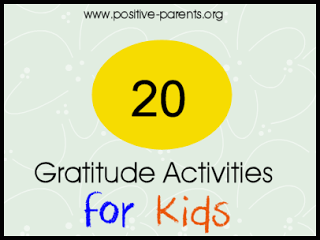
In November, many people share something they’re thankful for each day on social media in preparation for the Thanksgiving holiday. Practicing gratitude makes us feel happier and more alive. The benefits of gratitude are many, and if we teach our children the art of gratitude while they’re young, they’re more likely to reap the benefits well into adulthood.
These gratitude activities will help you cultivate an “attitude of gratitude” in your little ones.
1. Create a family gratitude book. Each family member should add photos, notes, drawings, and mementos - anything they feel grateful for. It’s a good idea to keep it visible and add to it regularly, like once a month at a family meeting.
2. I found a wreath I can actually make! This thankful turkey wreath is easy and festive. Just write what your kids are grateful for on the feathers.
3. Keep a gratitude jar on the kitchen table. Let the kids decorate it with fall stickers or leaves. Each day, tell everyone to write down one thing they’re thankful for and put it in the jar.
4. I love this gratitude tree from the Kids’ Activities Blog. Cut out leaves, have the kids write what they’re thankful for on them, and hang them on a branch.
5. Add the gratitude circle into your bedtime routine. Have the family sit in a circle and each person name something they’re grateful for.
6. Say grace before meals. A simple yet often overlooked gratitude practice, saying grace before we eat is a small way to teach kids to be thankful. If you’re not religious, here are some secular examples to give thanks.
7. Get the little ones active with the Gratitude Garden activity from All Done Monkey. If you have an energetic kid, this is a great activity.
8. Take a gratitude walk. Go on an evening stroll and look for things to be grateful for, like the beautiful leaves, the smell of rain, and the friendly neighbors.
9. Make a gratitude paper chain . Each day leading up to Thanksgiving, add one strip per family member to the chain. You should have a nice, long chain to decorate with on Thanksgiving Day.
10. For a multisensory approach to gratitude, check out this gratitude sensory bin from Learning Through Playing.
11. Have the kids write letters of gratitude to community workers and hand-deliver them. Ideas are
police, fire department, school, bank, and hospital.
12. Buy a jar and dig a hole! It’s time to make a Thanksgiving time capsule .
Just write what everyone is thankful for on strips of paper, roll them up and place them in the jar. Bury it in the back yard. Dig it up next Thanksgiving and read what everyone was grateful for last year, and then add new ones to the jar and bury it again.
13. These gratitude stones by Fireflies and Mudpies are a simple and cute way to cultivate gratitude in your little ones.
14. Read books about gratitude together. Check out this list from The Best Children's Books and this list from Montclair Library in California.
15. The Joy of Boys made gratitude pumpkins with strips of orange construction paper.
...continue reading the list at Creative Child

Published on November 03, 2015 10:49
30 Days of Play in November!
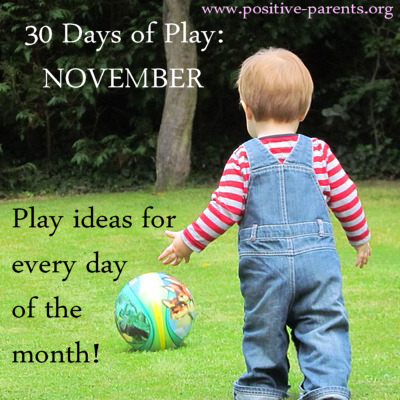
Last month , I began a new series, giving you simple and inexpensive play ideas for every day of the month. You asked for me to keep these posts coming every month, and so here are 30 fresh new play ideas for the month of November! Plus, since the season of Thanksgiving is upon us, check out these Thanksgiving traditions .
1. Play balloon tennis. Tape a paper plate to a paint stick for the tennis racket, and use a balloon as the tennis ball.
2. Build a town out of cardboard boxes. Cut holes for doors and windows, decorate the “buildings” with construction paper, crayons, glitter, or whatever else you have on hand, and use small toys and figures to occupy your town.
3. Pretend play detectives. Create clues for the kids to follow and see if they can solve the mystery!
4. Play traditional birthday party games even if it’s nobody’s birthday. Try these ideas.
5. Watch a Thanksgiving movie together after the big dinner. Here is a list to choose from.
6. Act out a children’s book, like We’re Going on a Bear Hunt.
7. Do karaoke.
8. Set up a science lab with beakers, test tubes, water, color tablets, and measuring spoons.
9. Visit a pumpkin patch.
10. Make a pumpkin pie together with the pumpkin you picked at the patch.
11. Do a Diet Coke and Mentos explosion for some fun outdoor science.
12. Paint each other’s faces with face paint.
13. Make a homemade corn pit. Fill a small baby pool with two 50-pound bags of corn from the local feed store. Add shovels and buckets.
14. Visit a local planetarium or science center.
15. Grab binoculars and go bird watching.
16. Play video games together.
17. Make a Thanksgiving craft. Here are plenty to choose from .
18. Blow up balloons with glow sticks inside and hang them from the bedroom ceiling for delightful nightlights.
19. Make homemade ice cream together. Here’s how .
20. Play I Spy.
21. Peel the paper off broken crayons and melt them in flexible shaped trays, like this .
22. Freeze small toys in a muffin tin and throw the iced toys in the bath. The kids will enjoy watching them melt to reveal the toy.
23. Work a puzzle together.
24. Go on a hayride.
25. Make pet rocks, rock people, and even a whole rock village.
26. Make a treasure map and go on a treasure hunt.
27. Visit a local corn maze.
28. Gather all the stuffed animals and set up a pretend veterinarian’s office, or for educational fun, sort them by habitat.
29. Make a beanbag toss game:
Cut out squares of felt.Hot glue 2 squares together on 3 edges, leaving a pocket opening.Fill with beans, and hot glue the last side shut.Cut out a hole in sturdy cardboard for the target, or just toss them into a basket or bowl.30. Play The Floor is Lava! Game:
Pull the couch cushions on the floor.All players must jump from cushion to cushion.Be careful not to step on the floor. It’s hot!This post was originally published at Creative Child.

Published on November 03, 2015 09:40
Enforcing Limits While Remaining Connected
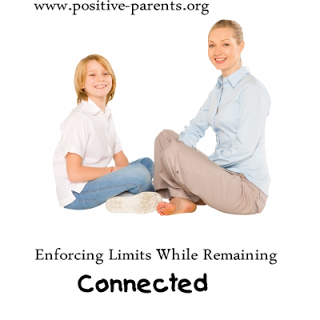
Enforcing Limits While Remaining Close with Our Kids
For the past 6 years, I’ve centered my work around one message: Connection is everything. It’s the key to parenting . It’s the best-kept secret . It’s our ticket to enjoying the journey more, but how can we set boundaries and correct our children without losing that connection? If we confuse “staying connected” with “never upsetting our children,” things begin to get very hazy.
Early on in my transition to respectful, connected parenting, I made the mistake of confusing the two. Fearful of ruining our bond, I struggled with setting and enforcing limits, and the frustration that resulted almost caused me to go back to my traditional punitive ways. Thankfully, I kept reading and learning, and finally I figured out how to be the positive leader my kids needed. So, if you’re struggling with something similar in your parenting journey, I’d like to share with you what helped me learn to stand firm yet gentle in my position as leader.
Here’s something to remember. A good connection isn’t feeble.
It isn’t going to break because you say no. It isn’t going to crumble when you hold a boundary or even allow a consequence. A temporarily upset child (or parent) doesn’t equal a broken bond. When I was tip-toeing around my kids, afraid of breaking our connection by upsetting them, I felt powerless to change their behavior. When I realized our relationship wasn’t that fragile, I was able to set and enforce limits and correct my children’s off-track behavior with confidence.
Think of parenting like a balance scale for a moment.
There should be lots of positive, happy, snuggly, smiling moments and fewer negative (correcting, reprimanding, upsetting, frustrating) moments. The positive should outweigh the negative a good deal. When we focus too much on correcting or reprimanding and don’t give enough positive attention, the scale starts to tip in the wrong direction. When the negative outweighs the positive, connections crumble.
Therefore, to keep your connection secure, make sure your scale is favorable. If you’re going through a particularly challenging phase, up the positive attention!
Ah, but there’s a small caveat. Even though we may have fewer negative moments than positive moments, being harsh or shaming during correction and enforcing of limits is damaging to the relationship. In other words, saying “no, I won’t allow you to do that” isn’t damaging, but “you’re a bad boy, why would you be so mean?” is.
It turns out that shaming is a pretty common thing, and although children are very forgiving when we blow it , harsh words and actions leave their mark. So, learning how to approach negative behavior in a positive way is important for keeping our connections strong, and this requires a shift in mindset and approach.
Changing Your Mindset
Positive parenting requires a shift from a fear-based mindset to a love-based mindset. The fear-based mindset says:
I must control my child’s behavior. (authoritarian)My child learns not to repeat bad behavior by being punished. (authoritarian)I’m the dominant figure; my child is “under” me. (authoritarian)My child will hate me if I upset him. (permissive)Trying to positively parent with a fear-based mindset doesn’t work because the focus is still on who has the control, you or your child.
The love-based mindset says:
My role is to teach my child appropriate behavior.My child learns through example and through limits set and enforced respectfully.While I am the leader, my child is a human being with equal rights to be respected and heard.The real shift occurs when you move away from controlling your child’s behavior toward understanding your child’s behavior. Only when you understand where it’s coming from can you help him learn to do better.
Changing Your Approach
Now that the focus is off control and on connection and understanding, how do you approach correcting her of enforcing your limit while maintaining your connection? ...continue reading at Creative Child

Published on November 03, 2015 09:23
October 18, 2015
50 Ways to Love a Child
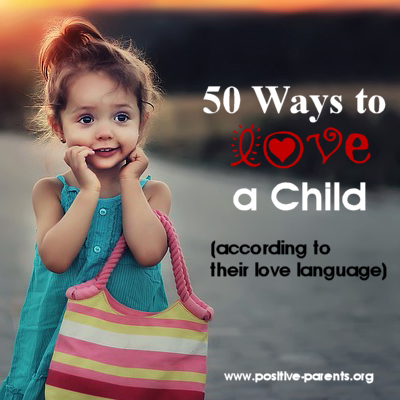
We have such a deep love for our children. Everything we do, every decision we make from the time they come into our lives, we do because we love them so very much. The question is, though, how much do they feel our love? We may say it a hundred times a day, but are we really speaking their language?
In The 5 Love Languages of Children , authors Gary Chapman and Ross Campbell outline the 5 different ways children receive love. All children receive love through each language, but for each child, there is one particular that has the loudest voice. This personal love language fills their tank the fastest. This is important because when a child’s tank is full, when they feel loved and connected , they are happier, more cooperative, and they take in what we teach much more readily.
If you aren’t sure what your child’s love language is, you can take the assessment here .
Don’t have time for the assessment? Ask yourself these three simple questions:
How does my child show love to me?What do they often request?What makes their eyes light up?When speaking your child’s love language, attitude is everything. When doing an act of service or giving a gift, for example, it must come from a genuine place of wanting to show love and never be for the purpose of bribing or manipulating a child. It’s important to communicate genuine, unconditional love to fill their tanks with.
Physical Touch – Physical affection is an easy way to show our love. Most children are receptive to this language, and for some, it speaks the loudest.
Here are 10 ways to show love to the child whose love language is physical touch.
Hold hands when you walk side by side or when you tell stories.Give high fives.Offer lots of hugs and kisses.Sit close or invite them on to your lap.Give back rubs or foot massages.Touch their shoulder when talking or making a request.Ask often if they need a hug or cuddle.Offer hugs and cuddles after correction.Play Twister, roughhouse, or other physical games.Make up a special secret handshake between the two of you.Words of Affirmation – Every child blossoms with words of encouragement and positive guidance. These kind words nurture a child’s sense of worth and feelings of security. For some children, this is how they receive love the best. Be aware that criticism and a harsh tone of voice or negative body language are particularly hard on children whose primary love language is words of affirmation.
Here are 10 ways to show love in this language.
Give the child a sweet nickname.Leave notes in their lunchbox.Say “I love you” first and often.Tell them why you like them .Verbally affirm their positive actions.Tell them you’re proud of them.Offer sincere, heartfelt compliments.Verbalize your love after correction.Write notes, cards, or letters.Find something off of this list of 64 Positive Things to Say to Children to say each day.Quality Time – Spending time with our children when we are intently focused on them, pushing aside our agendas and distractions, is a beautiful gift. Quality time says “You are important to me. I like spending time with you.”
If Quality Time is your child’s love language, here are 10 ways to fill her tank.
Play with them without distractions.Read together.Go on mommy/daddy dates. Here are some ideas .Let your child choose how to spend the time together.Cook together or have dinner together regularly.Tell them stories of your childhood.Laugh and tell jokes.Practice active listening . Create traditions .Spend quality time together after correction.Gifts – All children like gifts, but for the child whose love language is gifts, it’s not about just collecting objects. The gift is a symbol of the thought behind it. It says, “I was thinking of you.” The cost is not important.
Here are 10 meaningful ideas for speaking this language. Finish reading this article at CreativeChild.

For more of my Positive Parenting articles featured in Creative Child Magazine, click here.
Published on October 18, 2015 11:44
7 Ways to Stop Misbehavior
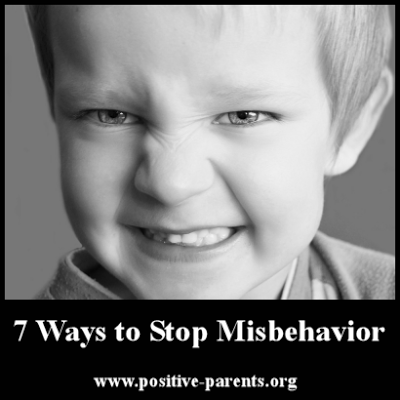
Children behave the way they do for a reason, and rather than simply looking to punish the behavior, positive parenting is about looking for and addressing the reasons behind it. Below, I’m outlining 7 top reasons children misbehave and to address each one, so as to stop the misbehavior.
Remember, punishing a misbehavior may stop it temporarily, but it doesn’t solve the problem underneath, and often times, that problem will just manifest in other ways until it is addressed and solved.
Reason #1: Attention
It’s a simple fact that children need a lot of attention, yet we tend to get frustrated at them when they display certain behaviors “just to get our attention.” I love what Dr. Gordon Neufeld says about this: “If we see a child who wants attention, why wouldn’t we give it to him? Why wouldn’t we meet this basic need?”
In today’s buzzing and distracted world, we can spend the entire day in the presence of our children and still not give them much attention. It can be difficult to juggle all the balls we have in the air. It comes down to prioritizing. If you give most of your focused attention to your child when she misbehaves, that’s likely what she’ll keep doing. On the other hand, if you give plenty of positive, loving attention, there will be no need to misbehave to get it.
If you suspect attention is the reason behind your child’s misbehavior, try these tips:
1. Practice active listening whenever you can.
If your child is speaking to you, make a point to stop what you’re doing, make eye contact, and listen with the intent of understanding. If you cannot do so at that moment, say, “I’d love to hear what you have to say. Give me a few minutes, and I’ll give you my full attention.”
2. When your child is engaged in positive behaviors (is being helpful, kind, or cooperative), offer genuine, descriptive feedback. This is not the same as “good job.”
Descriptive feedback says:
“I see you. I’m paying attention!”It means you notice the effort, not just the outcome.It’s “Thank you for being patient while I was on the phone. I see you were wanting to show me your drawing, but you waited. I appreciate that” rather than “good job not interrupting.”3. If you have more than one child, you already know they can compete for your attention.
Solve this by carving out one-on-one time with each child. It doesn’t have to be a really long amount of time; even a few minutes of focused attention a day can have a positive impact on behavior.
Reason #2: Independence /Control
Your toddler always responds with “NO!” Your preschooler refuses to leave the playground and a tantrum ensues. At some point after our little people realize they are separate beings from us, they start wanting to exert some independence. They want control over which cup they use, what they eat, what they wear.
This can be frazzling for parents who just want their children to drink out of the cup that’s clean without crying about it, or to eat their healthy meal, or to not wear the Batman costume to the grocery store…again!
So how can you stop misbehavior caused by a desire for control? Try these tips:
1. Know when to concede.
Does it matter if she must have the red cup? Will wearing that mismatched outfit cause a problem? Will it hurt to be washed off standing up rather than taking a full bath? Yes, sometimes children must go by our rules. Ultimately, we have the final say, but it’s good to give away control where you don’t really need it. Besides, these small doses of independence now is training ground for making bigger choices later.
2. Be clear about what is non-negotiable.
If you’re giving up control over the small things that don’t matter, your child will be more likely to comply when it does. Be firm during the times when there is no choice by not leaving it up for debate. There is only a power struggle when both people are pulling, so don’t pull. Instead, take action. If you asked your child to pick up his toys and he didn’t, calmly walk him over to the toys and point to them. If he still resists, try a when/then statement. “When these are picked up, then you can go play.”
3. Teach your child to say “no” respectfully.
It is important to retain the ability to say “no.” Your child will need to be comfortable saying “no” all through life, so teach her how to say it respectfully by offering a reason and an alternative. “I would prefer to clear the tablet after dinner than to set the table now because I'm in the middle of this game.” Of course, this takes time to teach, so be consistent and model this when you must say “no” as well.
Reason #3: Copying Others
He repeats a bad word he heard on television. She tries out the name-calling she heard from her BFF. If your child is copying the poor behavior of others, it’s time to be more stringent about what they’re exposed to. Monitor online activity, television shows, and music. Pay attention to their peer relationships.
You can’t have complete control over what they’re exposed to, especially once they’re older and in school. However, it is the parent’s responsibility to both protect them from as many negative influences as possible and teach them how to make good choices when those negative influences are present.
Here’s how to stop copied misbehavior:
1. Realize that some copying is normal.
It’s just part of growing up and learning. Stay consistent about your family rules and expectations.
2. Minimize exposure to the bad influence.
If one particular friend seems to be the bad influence, limit playdates or be the one to host them so you can keep a watchful eye.
3. Banish hurtful words.
If your child picks up negative language, set clear rules about appropriate language and help her express herself in a more appropriate way. “It hurts your brother’s feelings when you call him ‘stupid.’ Hurtful words are not allowed in our family. If you're upset with him, say ‘I’m upset with you right now, please leave me alone’ but don’t call him names.”
Reason #4: Connection
A strong connection is what gives us influence with our children. If that connection is strained, they are more likely to misbehave. Even if your bond has taken a downward turn and your child is acting out, you can stop the bad behavior.
Here are some ways you can stop the misbehavior and strengthen your relationship:
1. Make sure you’re speaking your child’s love language .
Their particular love language is what fills their tanks the fastest. Ensuring that your child feels deeply loved, speaking their language, will help your connection flourish.
2. Make time for play.
Go into their world for a while and let them direct the play. This kind of focused attention builds connection fast.
3. Find reasons to laugh together.
Watch a funny movie, tell jokes, dress up in goofy costumes, or play a silly game. Laughter brings us closer together and helps dissipate any negative feelings we may be carrying.
4. Check out these resources for other ways to connect with your children:
10 Ways to Connect With Your Child Communicating Positively With Children Playful Parenting Reason #5: Lack of Skills
...continue reading this article at Creative Child.

For more of my Positive Parenting articles featured in Creative Child Magazine, click here.
Published on October 18, 2015 11:38
October 6, 2015
10 Super Stellar Sensory Activities

In their new book, Sensory Processing 101 , the authors describe the 8 sensory systems. These are:
The auditory system (sense of hearing) The olfactory system (sense of smell)The oral sensory system (sense of taste)The vestibular system (how we sense where our bodies are in space)The proprioceptive system (our sense of the way our bodies move)The tactile system (sense of touch)The visual system (sense of sight)The interoceptive system (general sense of our body’s physical system, such as hunger).These sensory systems work to take in information from the child’s surroundings and send it to the nervous system, which processes it and generates a response or reaction. Sensory processing, then, is the way the body receives, analyzes, and responds to the information received from the environment. The authors say that, “Thoughtful, guided exposure to playful sensory experiences is the best way to promote healthy development of the sensory systems.”
From Sensory Processing 101, I’ve chosen 10 of my favorite sensory activities that will help your child develop these systems well. There are many more to choose from in the book so be sure to check it out!
Activity 1: (Oral Sensory System Activity) Mouthercises:

Demonstrate each of these sounds and movements and ask your child or children to imitate.
Buzz like a bee.Make a clicking noise with your tongue.Pucker up and make loud kissing noises.Open your mouth wide and say “AAAHHHH!”Press your lips together tightly and say “MMMMMMM!”Blow up your cheeks big like a bubble and then use your hands to “pop” the bubble.Stick your tongue out as far as you can.Have a silly face contest.Activity 2: (Auditory System Activity) Blindfold Navigation
Set up a simple, safe course to navigate. Take turns being the leader and the follower. The follower gets blindfolded and the leader gives verbal directions to move around the course, such as “take 3 steps forward and turn right.” You may want to start practicing without the blindfold first, and make sure this activity is always supervised by an adult.
Activity 3: (Visual System Activity) Doodle Guessing Game
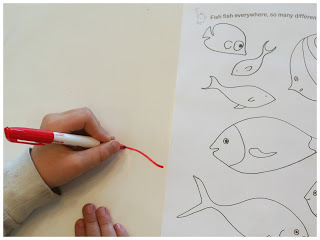
Cut out pictures from magazines or use photographs. Gather dry erase markers and clear plastic sheet protectors. Place a picture and a clear plastic sheet protector side by side on a table. Tell the child to find a specific object in the picture.
For example, if it’s a photo of children playing on a playground, ask your child to find the slide. Give him a marker and ask him to outline or circle on the sheet protector where he thinks the object would be if the sheet protector were placed on top of the image. Then place the plastic sheet protector on top of the image and see how the circles match up with the objects.
Activity 4: (Olfactory System Activity) Smell and Feel
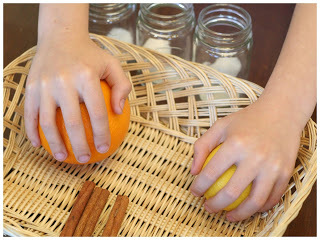
For this activity, you’ll need empty containers, cotton balls, scented oils, and objects to match each scent to, such as a lemon and an orange, and so on. Add 1-2 drops of oil to a cotton ball. For very young children, start with familiar scents, like orange and berry. Place one cotton ball in each container, and place the real objects on the table in front of your child. Talk about the items on the table. Then blindfold the child. Give her one of the scented containers with a cotton ball inside and ask her to feel her way around the table to find the matching object.
Activity 5: (Auditory System Activity) Repeat My Rhythm
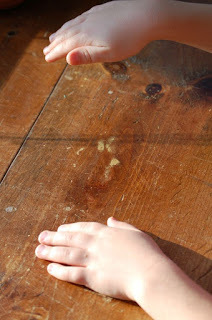
Tap a simple rhythm on the table and ask your child to imitate it. Then let your child tap the rhythm and you try to imitate it. Start with just a few beats and get increasingly more complex.
Get creative and use household items to create a beat!
wooden spoonspots and pansplastic bottlespens and markers
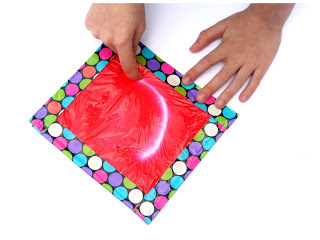 Activity 6: (Vestibular System Activity) Donkey Kicks
Activity 6: (Vestibular System Activity) Donkey Kicks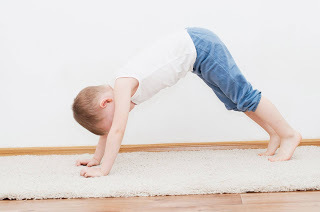
Start in a standing position. Lean over and put both hands and feet on the ground. Make sure nothing is behind you! Keep your hands on the ground and jump with your legs kicking behind you.
Activity 7: (Proprioceptive System Activity) Hot Lava
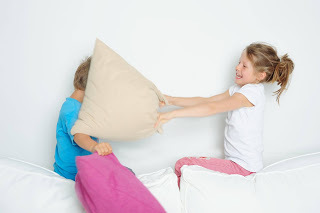
Scatter pillows around the floor. The floor is lava and the kids must jump on the pillows to stay safe. For added fun, mom or dad can be the “lava dragon” who chases them around!
And of course when there are pillows, there will be a lot of fun to be had!
Activity 8: (Proprioceptive System Activity) Bubble Wrap Stomp Art
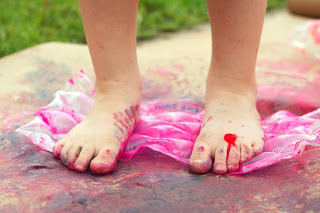
You’ll need washable tempera paint, large paper, and various sizes of bubble wrap. Squirt the paint on the paper in drops or lines. Cover with bubble wrap and let your child jump all over it with bare feet. Slowly pull off the bubble wrap to see the results.
Activity 9: (Visual System Activity) Mirror Mirror
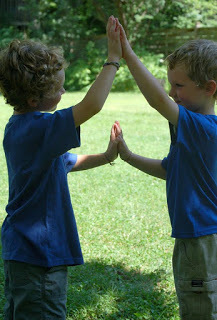
Have kids pair up (or you be the partner) and designate someone to be the leader of each set of partners. Each set of partners should stand face to face. When the leader changes position, the partner has to mimic the position. The leader continues changing position with the partner mimicking. Switch partners and repeat.
Activity 10: (Tactile System Activity) Mess-Free Finger Painting
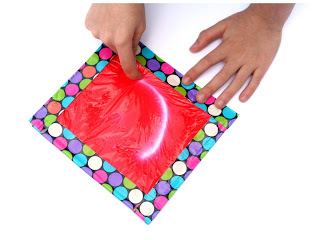
This activity is great for children who are hypersensitive to tactile input. Fill a plastic freezer bag with a few drops of two different colors of paint. Tape the bag to the table on top of a white piece of paper and let your child paint without the mess.
Check out Sensory Processing 101 for more great activities plus check lists, reference guides, and even an index of behaviors! These playful activities not only help your child develop healthy sensory systems, but they’re a great way for you to play and connect each day.
Have fun!
As published at Creative Child

Published on October 06, 2015 14:11
October 1, 2015
31 Days of Play: October
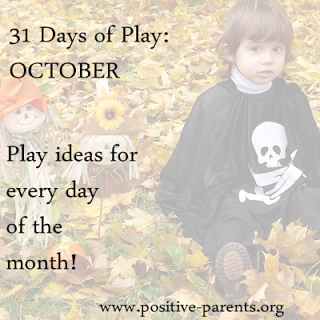
Play is an important part of maintaining connection with our kids, but with so much to do every day, it can be difficult to find the time and energy. Here are 31 ideas, one for each day of the month, that don’t take a lot of time or money. Commit to playing a little every day and see what a difference it makes in your home!
Make a fall-themed sensory bin and explore it with your child. Check out these 10 fun bin ideas for some inspiration.Grab a few leaves from the yard and do leaf rubbings or do one of these leaf crafts .Make a fun treat together. These ghost cookies are easy and really cute!Rake a pile of leaves together and jump in them.Play a card game. We like Uno the best.Make sculptures with toothpicks and miniature marshmallows.Go pumpkin bowling ! Make ghost faces on 6 rolls of toilet paper and stack them up. Drill holes in a pumpkin like a bowling ball and see who can knock down the most ghosts!Start a new read aloud and read for 30 minutes before bed every night. Our favorites are The Chronicles of Narnia books. Here is a great list .Decorate pumpkins. For a fun alternative to carving, try cookie cutters and a rubber mallet to pound shapes into the pumpkin, or pick up a craft kit at your local Dollar Store.Have a drawing contest, or play Win, Lose, or Draw !Dress up and a photo shoot.Amaze your child with a simple magic trick , then teach him how to do it too!Get out the pots and pans and make your own band, and perform!Have a dance party.Make an indoor obstacle course.Play hot potato.Build with wooden blocks or Legos together.Play indoor hopscotch using masking tape on the floor.Play Simon Says, Red Light Green Light, or Musical Chairs.Make paper airplanes and fly them.Make 10 sticky notes and put them on the walls in your child's room. On each one, write one thing you love about them. If they're too small to read, draw them little pictures, and tell them what you drew.Play a board game like Candy Land or Scrabble.Make dinosaur fossils with playdough and toy dinosaurs. Imprint and let dry.Go on an evening hike through the autumn trees .Go on a ghost hunting adventure with white balloons and NERF guns!Set up a scavenger hunt.Go geocaching! Great resource here! Grab your pillow cases and have a sack race.Stay up late and watch a family friendly scary movie.Drive around a nearby neighborhood to look at Halloween decorations.Bake apple pies together.Have fun with your family and enjoy all 31 days of October! Show us some of your fall photos in the comments below!
This post was originally published at Creative Child.

Published on October 01, 2015 09:48
September 16, 2015
The Brain Science That Changes Parenting
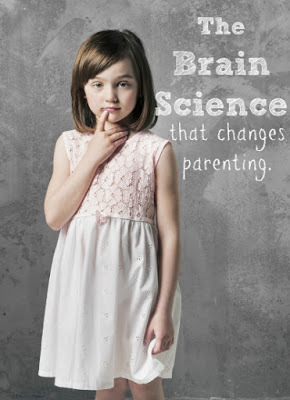
I have been fascinated by neuroscience for several years now. In fact, learning about basic brain function and child development is why I chose to leave conventional parenting methods behind. I’m certainly no neuroscientist, and I still don’t understand the deep complexities of the brain, but I’ve come to understand the basics through No-Drama Discipline by Drs. Daniel Siegel and Tina Payne-Bryson.
Dr. Siegel is a clinical professor of psychiatry at the UCLA School of Medicine. Dr. Bryson is a psychotherapist and the Executive Director for the Center for Connection . What they share in their book is huge, paradigm-shifting information that every parent needs to know. I’m going to share with you just a snippet that I feel is extremely important. Of course, I recommend adding their book to your library.
Let’s divide the brain into parts. The lower region of the brain is what Drs. Siegel and Bryson refer to as the “downstairs brain.” This is made up of the brainstem and the limbic region. The brainstem is our primitive “reptilian” brain and is responsible for operations such as breathing, digestion, and regulating sleep cycles. The limbic system houses our strong emotions. The downstairs brain is well developed at birth, so your child feels all of the strong emotions from the get-go, but managing those emotions is not a function of the lower brain.
The upper region, or upstairs brain as the authors call it, is made up of the cerebral cortex, the outermost layer of the brain. The upstairs brain is responsible for logical thinking, reasoning, making decisions, planning, regulation of emotions, empathy, morality, and much more, and this is very underdeveloped at birth. In fact, it won’t be fully formed until the mid 20’s.
Why does this change everything?
It takes the information we’ve been fed for years, such as the idea that a child who hits is just being mean and needs punished or that a toddler having a meltdown is being manipulative and needs ignored, and blows it completely out of the water. None of that is true! A child having a downstairs tantrum (true emotional overwhelm) cannot just stop the tantrum no matter how much you threaten or bribe her to, because she’s locked in her primitive downstairs brain and cannot access the part that houses reason. A child who hits someone has lost access to his very underdeveloped upstairs brain and is reacting from his primitive brain. He’s not mean – he’s simply not capable of controlling his emotions and behavior all the time.
Does this excuse bad behavior? Do we just let it go since they can’t help it? ..Finish reading this article over at Creative Child

Published on September 16, 2015 19:37
September 9, 2015
The Best-Kept Secret in Parenting!
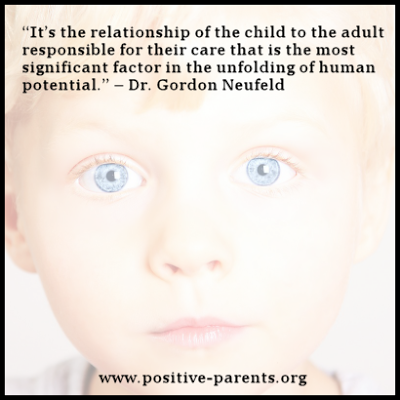
“It’s the relationship of the child to the adult responsible for their care that is the most significant factor in the unfolding of human potential.” – Dr. Gordon Neufeld
Dr. Gordon Neufeld is a Vancouver-based developmental psychologist with over 40 years of experience with children and youth and those responsible for them. A foremost authority on child development, Dr. Neufeld is an international speaker, a bestselling author Hold On To Your Kids and a leading interpreter of the developmental paradigm.
I recently had an opportunity to listen to him speak on The Great Parenting Show , and what he said is so profoundly important that I want to try and summarize it, because I don’t want this to be the best-kept secret anymore. What is this secret?
It’s the relationship of the child to the adult responsible for their care that is the most significant factor in the unfolding of human potential.
Attachment, not behaviorist approaches. It’s not the discipline tricks or techniques that we use to try and modify behavior that makes children want to be good – it’s the quality of our relationship! This has the potential to profoundly change the way we parent since much of parenting is still based upon behaviorist techniques that actually erode the relationship.
For example, time-out is a social exclusion technique that is supposed to be emotionally painful enough to deter the unwanted behavior, yet when we exclude children, when we withdraw the invitation to exist in our presence, as Neufeld puts it, the relationship gets damaged. The same is true for removal of items and privileges. When we say to the child, “Whatever it is that you are attached to, whatever you care about, I will take that away from you when you are not good,” this essentially is corroding the very thing that makes them want to be good.
Neufeld outlines the 6 stages of attachment in his book, Hold On To Your Kids , and those have been summarized here . I want to point out for this particular discussion stage 3 - belonging or loyalty.
It is during this stage, which occurs around 3 years of age, where the child begins wanting to be good and do right for the parent if the attachment bond is strong. In stage 5, the child becomes very emotionally involved, giving his heart to whomever he’s attached. Neufeld says, “There is nothing more important to hold sacred than the child’s desire to be good for you…when we have a good relationship with somebody, we naturally desire to be good for them and make things work for them.”
This is where we have taken a dreadful wrong turn in our parenting, because when children begin to test boundaries, we act as though they do not want to be good for us, and we start using tricks and techniques that push them away rather than bringing them close. These techniques – time-out, removal of beloved items, and certainly spanking – make no sense when we understand that the relationship is the most significant factor of all.
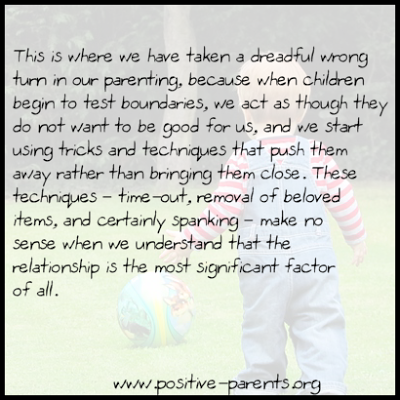
This knowledge makes parents then ask the question, “But how do I discipline? If time out and taking things away aren’t good, how to I stop bad behavior?” We ask because we are still looking for tricks! We have been so conditioned to believe that we must do something to the child to stop poor behavior that we cannot rest in the knowledge that a close, connected relationship will cause the child to want to behave.
This, of course, doesn’t absolve us from needing to teach our children how to manage their behavior – that is parenting – but the teaching is done in the context of the attachment. Point the child in the right direction (instill your values, show them what is expected, model well, talk about emotions and behavior) and make sure you have her heart. If you have her heart, you don’t need anything else.
Here is a 3 minute video of Dr. Gordon Neufeld explaining the effectiveness and consequences. There are several other helpful videos found at this link .
This article was originally posted on CreativeChild.com

For more of my Positive Parenting articles featured in Creative Child Magazine, click here.
Published on September 09, 2015 21:19



